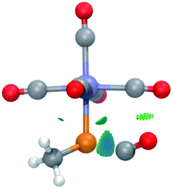Coordination of CO to low-valent phosphorus centres and other related P–C bonding situations. A theoretical case study†
Abstract
The multi-faceted bonding of CO in molecular phosphorus compounds is described using calculated P–C bond strengths as a criterion. Full compliance matrices at coupled cluster level of HPCO (1a), singlet oxaphosphirane-3-ylidene HP(η2-CO)), the dimer (HPC![[double bond, length as m-dash]](https://www.rsc.org/images/entities/char_e001.gif) O)2 as well as P
O)2 as well as P![[triple bond, length as m-dash]](https://www.rsc.org/images/entities/char_e002.gif) CH, HP
CH, HP![[double bond, length as m-dash]](https://www.rsc.org/images/entities/char_e001.gif) CH2 and H2P–CH3 were calculated to obtain quantifiable data and enable comparison. The quest for CO coordination and activation was examined for phosphaketenes 1a–f: the P–C compliance constants (in Å mdyn−1) reveal a clear trend that shows a weakening of the P–CO bond strength from 1a to mono-ligation as in [(OC)5W{P(CO)Me}] (1c) (0.301), in H3BP(CO)Me (1b) (0.322), to bis-ligation as in [{(OC)5W}2P(CO)R] (1f) (0.488) to (H3BP)2(CO)Me (1d) (0.649). Availability of p-type electron density at phosphorus drastically strengthens the P–CO bond and weakens the C–O bond via π–back-donation, bis complexes are better described as weak CO (C→P) adducts to phosphorus. In complexes [(OC)5W{P(CO)R}] the CO activation by phosphorus equals that of CO activation through tungsten in pentacarbonyltungsten complexes. A comparative study of various CO bonding motifs in molecular compounds indicates that acyclic (2) or cyclic diphospha-urea derivatives (2–5) or isomers (6) display P–CO bond strengths (compliance constants range 0.502–0.640) well below that of the P–C bond of H2P–CH3 (0.364), thus providing insight into the bonding and the ease of CO extrusion, experimentally known for some cases. A highly unusual adduct of CO was obtained in silico through two-fold P-ligation in diphosphiren-3-ones 2a–d, the parent compound of which was found to be properly described as a side-on (P
CH2 and H2P–CH3 were calculated to obtain quantifiable data and enable comparison. The quest for CO coordination and activation was examined for phosphaketenes 1a–f: the P–C compliance constants (in Å mdyn−1) reveal a clear trend that shows a weakening of the P–CO bond strength from 1a to mono-ligation as in [(OC)5W{P(CO)Me}] (1c) (0.301), in H3BP(CO)Me (1b) (0.322), to bis-ligation as in [{(OC)5W}2P(CO)R] (1f) (0.488) to (H3BP)2(CO)Me (1d) (0.649). Availability of p-type electron density at phosphorus drastically strengthens the P–CO bond and weakens the C–O bond via π–back-donation, bis complexes are better described as weak CO (C→P) adducts to phosphorus. In complexes [(OC)5W{P(CO)R}] the CO activation by phosphorus equals that of CO activation through tungsten in pentacarbonyltungsten complexes. A comparative study of various CO bonding motifs in molecular compounds indicates that acyclic (2) or cyclic diphospha-urea derivatives (2–5) or isomers (6) display P–CO bond strengths (compliance constants range 0.502–0.640) well below that of the P–C bond of H2P–CH3 (0.364), thus providing insight into the bonding and the ease of CO extrusion, experimentally known for some cases. A highly unusual adduct of CO was obtained in silico through two-fold P-ligation in diphosphiren-3-ones 2a–d, the parent compound of which was found to be properly described as a side-on (P![[double bond, length as m-dash]](https://www.rsc.org/images/entities/char_e001.gif) P)→(C
P)→(C![[double bond, length as m-dash]](https://www.rsc.org/images/entities/char_e001.gif) O) complex, in contrast to its aza-analogue 2aN. A drastic weakening of the P–CO bond strength is observed from P2CO (2a) (0.502) to the C2-symmetrical (H3BP)2CO (2b) (0.913); the latter represents an extreme case of a weakly bound CO. Furthermore, calculated 31P NMR shifts and scalar 1J(P,E) couplings were correlated with P–CO and PC–O compliance constants as a tool for experimentalists.
O) complex, in contrast to its aza-analogue 2aN. A drastic weakening of the P–CO bond strength is observed from P2CO (2a) (0.502) to the C2-symmetrical (H3BP)2CO (2b) (0.913); the latter represents an extreme case of a weakly bound CO. Furthermore, calculated 31P NMR shifts and scalar 1J(P,E) couplings were correlated with P–CO and PC–O compliance constants as a tool for experimentalists.


 Please wait while we load your content...
Please wait while we load your content...